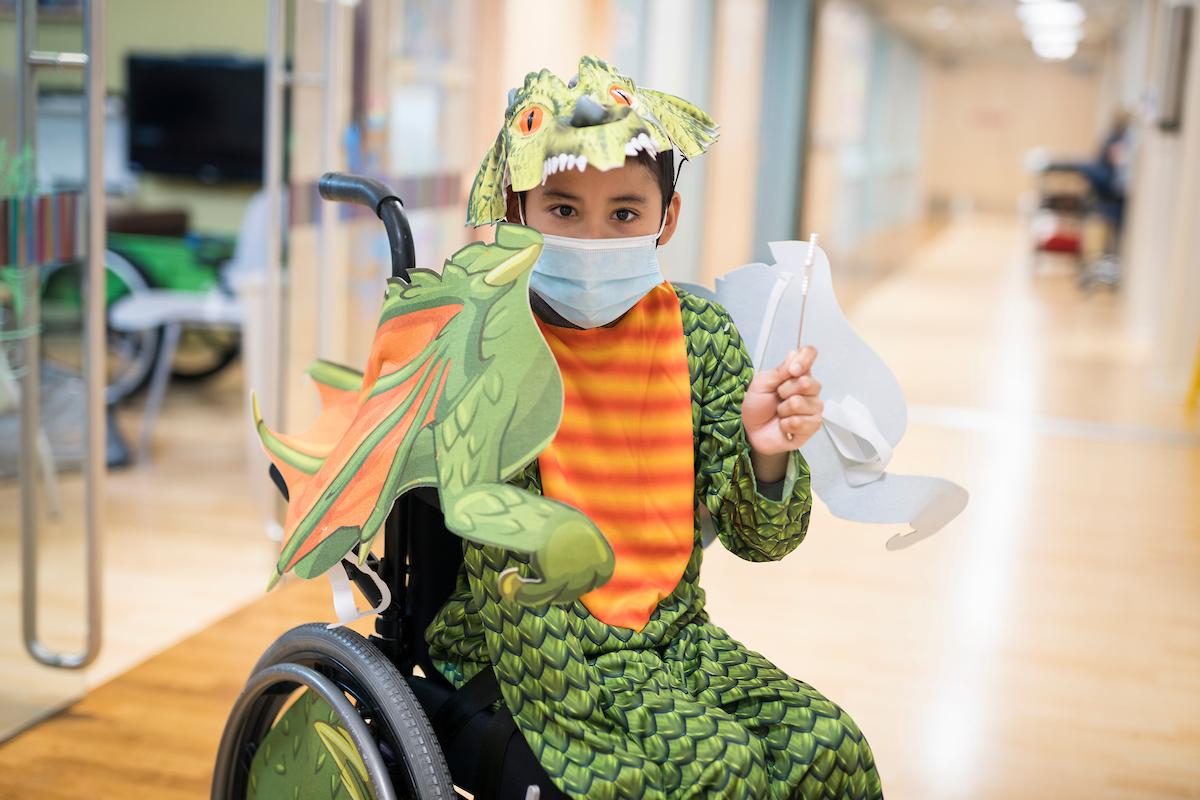
Kate Harkness works with an occupational therapist to build her strength following her selective dorsal rhizotomy (SDR) surgery at Gillette.
Catherine Harkness is all about pink, unicorns, and defying expectations.
The five-year-old, known as Kate by her family, is also focused on working hard to recover from her recent selective dorsal rhizotomy (SDR) surgery at Gillette Children’s Specialty Healthcare.
Kate and her twin brother, Bennett, were born at 23 weeks and 2 days.
“I had four rounds of IVF to have these little miracles,” recalls Kate’s mother, Sarah Harkness. “At my 20-week checkup both Kate and Bennett looked great. Then at 23 weeks I suddenly went into labor. It was such a scary time.”
Kate was 1 pound 2 ounces at birth and Bennett was 1 pound 7 ounces.
“Both of my babies were born with serious health issues,” Sarah says. “Both of them spent a long time in the NICU fighting to get stronger.” Kate spent 158 days in the NICU and had five surgeries while she was there. Doctors at the hospital where the twins were born told Sarah and her husband, Paul, that once their children were released from the NICU they would need to monitor them closely and suggested they reach out to specialists at Gillette.
“They suspected Kate had some form of cerebral palsy,” Sarah says. “As a parent when you hear CP you’re sort of in shock. I didn’t know there were various levels of CP from mild to more complex. The doctors said, ‘Gillette is the place to go. It sets the bar on caring for kids who have CP.’ So we monitored Kate and got in touch with the team at Gillette.”
Kate’s first official diagnosis of CP came from Gillette pediatric rehabilitation medicine specialist, Marshall Taniguchi, MD. “At age 2 Dr. Taniguchi recommended Kate get a sedated brain MRI. He looked at the results of the MRI and examined Kate. He explained that Kate’s CP is mostly in her lower extremities,” Sarah recalls. Taniguchi brought in members of the Gillette physical and occupational therapy teams to create a therapy plan. He also recommended ankle-foot orthosis (AFOs) that were custom molded to give Kate’s legs proper positioning and support. She also got a custom-fit walker.
“Dr. Taniguchi really helped us put together a great program for Kate,” Sarah says. “He mentioned the possibility of SDR surgery down the road but said we had a few years to think about that surgical option.”
SDR surgery is a procedure that treats muscle spasticity caused by abnormal communication among the brain, spinal cord, nerves and muscles. The procedure corrects muscle spasticity by cutting the nerve rootlets in the spinal cord that are sending abnormal signals to the muscles. The best candidates for SDR surgery typically have spastic diplegic cerebral palsy that affects the legs more than the arms.
SDR surgery is typically performed when a child is 4 to 7 years old and after a gait and motion analysis and a spasticity evaluation determines this irreversible surgery would be a benefit to the child.
Gillette is one of the top providers of SDR surgery in the U.S.
“We knew Kate would not want to settle.”
Both Kate and her twin Bennett continued to get stronger and enjoyed playing at home with their older brother Will. “We’re blessed to have a close family,” Sarah says. “Kate was moving around on her own but we could see she really was ‘toe walking’ and had issues with her gait.”
Sarah recalls she and her husband, Paul, had some intense conversations about SDR surgery. “We really struggled making this decision for her,” Sarah says. “Kate was walking but we thought ‘is this really good enough?’ We kept thinking of Kate as a teenager—could we look her in the eye and tell her ‘we didn’t take a chance on SDR surgery. We took the safe road and settled.’”
Sarah and Paul knew 5-year-old Kate was a spunky girl and would grow up to be an independent young woman. “We knew Kate would not want to settle. We knew we needed to do the SDR surgery,” Sarah says.
After talking to other parents who decided to have their child undergo SDR surgery and many conversations with Kate’s team at Gillette, the Harkness family decided to go ahead with the surgery.

Kate often gets help in her therapy sessions from her mother, Sarah Harkness, and special bunny Violet.
“There’s nothing better than seeing your child after surgery.”
“When you hear that after surgery your child will have six weeks of intense inpatient rehab therapy that can feel overwhelming,” Sarah says. “But when you put it into context—when you think that for six weeks of inconvenience for your family your child could improve their walking and quality of life—it’s worth it!
On January 20, 2021 pediatric neurosurgeon, Debbie Song, MD, performed selective dorsal rhizotomy (SDR) surgery on Kate. “Handing your child over for surgery never gets easier,” Sarah recalls. She and Paul are grateful the Gillette team called every 45 minutes or so during Kate’s surgery to provide updates.
“There’s nothing better than seeing your child after surgery,” Sarah exclaims. Kate initially spent about two or three days recovering from her SDR surgery in the Gillette Inpatient Unit. “The nurses were wonderful,” Sarah recalls. During the post-surgery period, while lying in bed, the nurses gently removed Kate’s knee immobilizers and she made a wonderful discovery. “My legs don’t feel tight!” Kate told her parents. That was the first sign that the surgery was helpful and Kate excitedly shared the news with her brothers Bennett and Will.
During every phone call and FaceTime session with her brothers Kate kept telling them about her “new legs.” Her twin, Bennett was excited to hear this news. He asked for help so he could write Kate a note stating ‘I can’t wait to play with you again and see your new legs!’
Kate’s recovery at Gillette is the longest period of time she’s been separated from her twin brother. “It’s been really difficult,” Sarah says. “Because of COVID-19 precautions Kate’s brothers are not allowed to visit her. We understand this and are glad Gillette is taking safety precautions. It’s just not easy for two 5-year-olds to be separated.”

Kate’s twin brother, Bennett, had help writing a note to his sister.
Making therapy sessions seem like play
The Gillette rehabilitation team created a custom rehabilitation program for Kate and got her up and out of bed around the third day post-surgery. “We really like to get the kids moving fairly soon after surgery,” Gillette pediatric rehabilitation medicine physician, Angela Sinner, DO, explains. “At that point the kids are interested in getting out of their inpatient hospital rooms and to begin getting stronger.”
Kate often takes her favorite stuffed rabbit, Violet, with her to her therapy sessions. Occupational therapist, Emily DeBreto and physical therapist, Erin Peterson, are happy to incorporate Violet into Kate’s therapy sessions.
Sarah Harkness is often tapped to help with the “play” part of therapy and she marvels at how the Gillette therapists make the hard work seem like fun. “When Kate wakes up she’s really excited to get going and do her therapy. It’s all like fun and games to her,” Sarah says.

Occupational therapist, Emily DeBreto, tries to make therapy seem like play for Kate and other children recovering at Gillette.
Gillette’s comprehensive inpatient rehabilitation therapy program is one of the largest in the Upper Midwest. The specially trained therapists and state-of the art facilities make Gillette stand out from other health care organizations that provide selective dorsal rhizotomy (SDR) surgery. Gillette is just one of three pediatric specialty programs in Minnesota accredited by the Commission on Accreditation of Rehabilitation Facilities (CARF).
Occupational therapist, Emily DeBreto, says one of the best parts of her job is helping kids become more confident and independent. “In OT we focus on helping kids with daily living skills like brushing their teeth, getting in and out of bed and self-cares,” she says.
Physical therapist, Erin Peterson, helps to build a child’s stamina, core strength and movement during her therapy sessions. “It’s really amazing to see how motivated our patients are and how far they can come in therapy,” Peterson says.

Physical therapist, Erin Peterson, helps Kate with her walking and mobility.
Never set limits
Sarah says her time at Gillette with Kate has given her time to reflect on how far her fragile, premature daughter has come. “As a family our philosophy is ‘we never set limits.’ If there’s a mountain to climb we’re going to climb it as a family and get to the top.”
Sarah encourages other parents considering SDR surgery for their child to talk to the experts at Gillette and to not be afraid of the surgery or the recovery. “Your kids will show you just how strong they are,” Sarah says. “Gillette has done wonders for our family and will be part of our life for a long time.”





 Click to open image gallery Kate Harkness Collage, image 1
Click to open image gallery Kate Harkness Collage, image 1 Click to open image gallery Kate Harkness Collage, image 2
Click to open image gallery Kate Harkness Collage, image 2 Click to open image gallery Kate Harkness Collage, image 3
Click to open image gallery Kate Harkness Collage, image 3